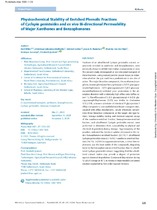| dc.description.abstract | Fractions of an ultrafiltered Cyclopia genistoides extract, respectively enriched in xanthones and benzophenones, were previously shown to inhibit mammalian α -glucosidase in vitro. The present study investigated ex vivo intestinal transport of these fractions, using excised porcine jejunal tissue, to determine whether the gut could be a predominant in vivo site of action. The major bioactive compounds, the xanthones (mangiferin, isomangiferin) and benzophenones (3- β -D-glucopyranosyliriflophenone, 3- β -D-glucopyranosyl-4- O - β -D-glucopyranosyliriflophenone) exhibited poor permeation in the absorptive direction with a relatively high efflux ratio (efflux ratio > 1). The efflux ratio of 3- β -D-glucopyranosyl-4- O - β -D-glucopyranosyliriflophenone (3.05) was similar to rhodamine 123 (2.99), a known substrate of intestinal P-glycoprotein 1 efflux transporters. Low epithelial membrane transport rates, coupled with efflux mechanisms, would effectively concentrate these bioactive compounds at the target site (gut lumen). Storage stability testing and moisture sorption assays of the xanthone-enriched fraction, benzophenone-enriched fraction, and ultrafiltered Cyclopia genistoides extract were performed to determine their susceptibility to physical and chemical degradation during storage. Hygroscopicity of the powders, indicated by moisture uptake, decreased in the order: benzophenone-enriched fraction (22.7%) > ultrafiltered Cyclopia genistoides extract (14.0%) > xanthone-enriched fraction (10.7%). 3- β -D-Glucopyranosylmaclurin, a minor benzophenone, was the least stable of the compounds, degrading faster in the benzophenone-enriched fraction than in ultrafiltered Cyclopia genistoides extract, suggesting that the ultrafiltered extract matrix may provide a degree of protection against chemical degradation. Compound degradation during 12 wk of storage at 40°C in moisture-impermeable containers was best explained by first order reaction kinetics. | en_US |

